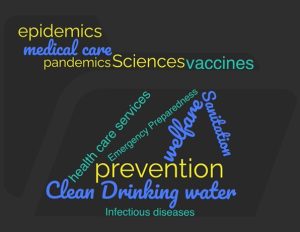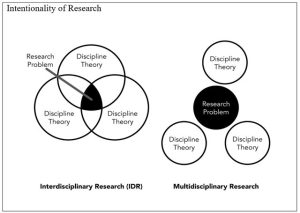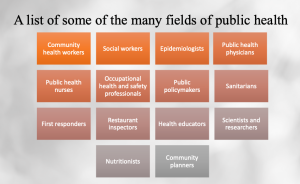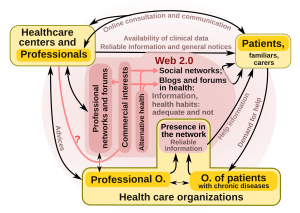Main Body
1 The Importance of Public Health
Hector (Giovanni) Antunez
|
Learning Objectives By the end of this chapter, the learner will be able to
|
 |
| “What is Public Health?,” Image created by Giovanni Antunez using Free WorldCloud.com Licensed CC BY 4.0 |
When you [the student] hear “public health,” what words come to your mind? – A classroom activity
At the beginning of the course, I asked my students to name words that refer to public health, I created (used) a word cloud online [see image above] and input the words that students frequently associate with public health. As seen in the image, the word prevention is a common word associated with the word, public health, similar common words are epidemics, clean drinking water, sciences, and others. This small activity at the beginning of the class motivates students to start learning more about public health. The activity is engaging since there are no right or, wrong answers, and every semester I used it, new words were mentioned, depending on the interest of the group. The activity ends with a general comment by me as the class instructor: “All of these are words (terms) associated with public health,” let’s review what experts, specific groups, or, authors define as ‘public health’.
Activity
What is Public Health? – Definitions
Starting with a general definition that is commonly used, then, looking at other definitions followed by what public health professionals do, which should help to understand the definition better, a definition of public health is evolving as many other areas as possible of study in sciences and medicine. There are several definitions, but one that is very common states:
The above definition has its basis in a 1920 definition by C.-E. A. Winslow in the publication, “The Untilled Fields of Public Health,” an article that has been cited in several publications and textbooks because it is still valid in many ways. [3]. However, having a definition does not guarantee that its content is understood by everyone as is the case of the public. It appears to be that a definition of what public health is is mostly clear for health professionals, but not for the public still, for example, when you ask a common person – not a public health student, or, any other health-related student, what is public health? Most people have a hard time responding to the question, and most of their answers show some level of insecurity as if the response is correct or, not. What is that? It is because as a relatively ‘young’ science, public health is still an area of science that is unclear for so many people, and it is often associated with negative events, or, unspecific situations. [4]
If we take the public health definition above, and list the main words of the definition, we will find the following: science, protection, safety, improvement of the health of communities, education [probably health education] … and the rest of the words in the definition refer to two areas in which there is still confusion in the public, these are, policymaking and research [on disease and injury prevention]. So, there is a need to find a way to make the definition of public health easier to understand for the common citizen or, individual, so, society can see the benefits of it. It appears that one way to clarify and understand the definition of public health is by looking at what public health does the American Public Health Association writes on one of its front pages, it says: “Public health promotes and protects the health of people and the communities where they live, learn, work and play.” Also, it adds: “… those of us working in public health try to prevent people from getting sick or injured… and it also adds, [public health] also promote[s] wellness by encouraging healthy behaviors”. [5]
Activity – Looking at other definitions of public health
Probably it will be helpful to look at other definitions of public health that are available in the medical, public health, or health in general literature. Conduct a web search of definitions of public health, and if possible, some examples of what public health does to better understand, and expand on the concept.
To start preparing your report, it recommended that you take notes. Use the space below to take notes. To check your notes, you can click “Check,” but before you hit “check” what you have written so far, copy and paste your work in a word processor editor such as MS Word or Pages. After you click “Check,” you will find two options, “See Solution,” to see some comments about your notes, click “Retry” to come back to the writing box. A final note: the content cannot be saved.
Why is public health important?
As seen here, an understanding of the definition of what is public health is a basic requisite to see its importance. From a general perspective, it can be said that public health is important as it is the science of prevention because it involves the community/population, it is necessary (important) for the improvement and protection of the overall quality of life on the planet earth, and also because of its global approach, what is needed here is also needed elsewhere in the world, e.g. sanitation, safe drinking water, etc. it assures existence (of the living and nonliving things that exist in the planet).[6]
If the agreement is that public health is important, then, its study is also important. It is accepted that public health is important and necessary for the survival of life on the planet, but also as it studies health phenomena using a comprehensive approach by being interdisciplinary.
 |
| Image: ‘tree of knowledge’. From Quora.net Public domain.
|
Public health is made up of multiple fields of study, medicine, epidemiology, biology, chemistry, anthropology, geography, math and statistics, computer sciences, social sciences, philosophy, etc. The science is the 'discipline', and the intersection of knowledge/content is the essence of the word, interdisciplinary. There are multiple benefits to an interdisciplinary approach compared to a multidisciplinary, and probably the major benefit is that one branch of science/knowledge enhances the other, or, expands the application, or, just clarifies the discussion point, or, the definition. See the image below representing this idea.
 |
| Image: ‘multidisciplinary vs interdisciplinary’. Taken from an article about models for Developing Interdisciplinary Research.[7] Modify and create new figure later in the process. |
Key Takeaways
Activity
Activity: to expand on the concept of public health as an interdisciplinary science, continue [I started the list just in the most recent paragraph above] by making a list of other science that in your opinion [or, by consulting Internet sources] are also part of the group of sciences or, disciplines that make up the field of public health. Check, for example, the article I used to prepare part of the content above from the University of Pittsburgh, School of Public Health. Careers in Public Health at https://www.publichealth.pitt.edu/careers/what-is-public-health.
Another way to see and understand how public health is an interdisciplinary science is by looking at the different areas of specialization or, expertise of public health occupations and careers. Just to make the point, a list of some of the many fields that are public health related are presented below:
 |
| Image created by Giovanni Antunez using MS PowerPoint. Licensed CC BY-SA 4.0 The list was prepared by using a web article from the American Public Health Association.[8] |
Public Health Achievements
Another way to continue expanding what public health is, and its importance is by looking at what it has done for humanity in the last 20th century. [9] See below:
The article by McDonough highlights what the The U.S Centers for Disease Control & Prevention consider the major contributions of public health in the Twenty Century
- Immunizations
- Motor-Vehicle Safety
- Workplace Safety
- Control of Infectious Diseases
- Declines in Deaths from Heart Disease and Stroke
- Safer and Healthier Foods
- Healthier Mothers and Babies
- Family Planning
- Fluoridation of Drinking Water
- Tobacco as a Health Hazard
Note: This information has been also called by CDC and others as the “10 great public health achievements in the 20th century.”[10]
Major Public Health Achievements in the Nineteenth and Twenty Centuries
Although some of the most significant achievements of public health have been outlined above, another way to look at the work of public health- which also justifies its importance, is by describing or, listing the factors that have contributed to the major achievements of public health. More of this will be also covered in detail in the chapter on the history of public health, but now, here it is important to briefly note what happened during these mentioned periods.
What years are the 19th and 20th centuries?
Many people find it challenging to understand how centuries are numbered in human history. There is a consistent rule that helps determine the correct numbering. The rule is as follows:
For the “Nth century,” take N and subtract 1. You will now get the beginning two digits of the years, by number.
For example, for the 20th century, we get 19xx…
For the 21st century, we get 20xx.
For the 23rd century, you’d get 22xx. (You’re welcome, Star Trek fans.)
For the 19th century, we get 18xx.
For the 13th century, we get 12xx.
Adapted from Overland, B. (n.d.). What years are the 19th and 20th centuries? Quora.[11]
Try the concept
The late 19th century through much of the 20th century periods
The major public health activities that contributed to the improvement of life during these periods, especially in the 19th century are sanitation, especially the availability of safe drinking water, the development of vaccines and antibiotics, and an expanded knowledge of diseases, especially infectious diseases. [12],[13] The field of microbiology played an important role in these periods with laboratories that now could identify agents and sources of infectious diseases. The same can be said with the design and implementation of environmental controls. Also, the science of epidemiology became systematized and valued as an important tool for the identification, control, and prevention of disease.
The progress made in the 19th and 20th centuries was possible because of the development of the epidemiological concepts of primary, secondary, and tertiary prevention (commonly known as, the ‘three levels of prevention”); which guided more comprehensively the work of scientific and organizational institutions and programs, including public health. It is in these times that the work of public health became an essential governmental function giving power to federal, state, and local tribal public health agencies.
Major second period, the mid-twenty-century evolution of public health
It was mainly in the second half 20th century that public health evolved more as a science, especially in the United States. The force behind this major change came from the publication of the Institute of Medicine (IOM) 1988 report known as, “The Future of Public Health”. [14] The publication came mainly in response to the lack of effectiveness by the public health system to manage the unprecedented rise of chronic diseases such as heart, cancer diabetes, and others, and the emergent threats at that time of the HIV/AIDS epidemic. The report pointed to the fact that the U.S. public health system was unprepared to face the challenges that require an effective intervention in response to these mentioned health problems which were also societal issues. [15]
In addition, the IOM 1988 report called for the need to set performance standards, and it proposed the core functions of public health to be used by public health authorities and its institutions and programs, which eventually gave a new direction to the work of public health in the nation (the U.S.). During this time also an emphasis on the need to establish more schools of public health to prepare the public health workforce in a more professionalized manner, since many of the public health workers at that time lacked a public health degree.
The new era, mainly the first quarter of the Twenty-First Century
This is the era of an enhanced public health practice that promotes collaboration and active community participation, emphasizing the need for effective leadership in all public health department functions and programs. As part of this new emphasis, the call is for public health organizations to enhance their skills and capabilities to interact with governmental and civil society agencies and programs in the provision of a more comprehensive public health service that responds to the changing needs of modern society. [16] There is also an emphasis on the professionalization of the work, an initiative that started at the end of the previous century.
The evolution of public health
Using the analogy of the development of the Internet and its first launched Netscape browser in the late 1980s, that is the time of static web pages with visitor’s counters and home pages linked to a series of sub-pages (or, ‘parent’ pages) which were linked to additional content, that period of the World Wide Web was called, Web 1.0. Later with the introduction of advanced search engines and web pages that were modified automatically over time, keeping the content updated with applications that assist the users; this second period of the World Wide Web has been called, Web 2.0. The third wave of innovation came with the introduction of highly improved search engines, the Cloud that provides storage to thousands of web pages and additional documents, web content that appears classified by categories, and all kinds of new gadgets, that is Web 3.0.[17],[18]
The above-mentioned analogy between the evolution of the World Wide Web and public health has been applied also to the history of public health by calling, the beginnings of it, “Public Health 1.0”, then, “Public Health 2.0”, to the improvements in public health infrastructure and delivery of services, which is, “Public Health 3.0”, which is characterized by a renovated vision and mission of public health and its work with the community and the multi-sectoral coordination between government and the civil society, especially non-governmental organizations, which also plays an important role in the delivery of medical and public health services.[19]
Public Health 1.0 refers to the period from the late 19th century through much of the 20th century when modern public health became an essential governmental function with specialized federal, state, local, and tribal public health agencies. [20]
As mentioned above, the second major period has been called, Public Health 2.0, which is a movement within public health that aims to make the field more accessible to the general public and more user-driven. The term is used in three senses. In the first sense, “Public Health 2.0” is like “Health 2.0″ and describes how traditional public health practitioners and institutions are reaching out (or could reach out) to the public through social media and health blogs.” [21] See the image that depicts this period:

“Health 2.0”, image by Jmarchn, Wikimedia, licensed CC BY-SA 3.0 |
Public Health 3.0, although there is more to say, the essence of the definition is around, “Transforming Communities. Public Health 3.0 emphasizes collaborative engagement and actions that directly affect the social determinants of health inequity.” This period emphasizes the work with communities and the different active organizations and institutions in those communities. [22]
There is more to refer to in general to the terms Public Health 1.0, 2.0, and 3.0, especially about the use of health technologies such as electronic records, which have transformed the delivery of health care services and what is known as telehealth, which is mainly used for medical training, and also to deliver care for the most part, especially during the COVID-19 pandemic which increased her popularity due to the need to offer contactless health care visits. ref?
But since the emphasis of this chapter is on the importance of public health, the content here will refer mostly to what are the main events that happened during each one of the eras in public health, which as made public health to gain relevance to communities and the study of population health.
Additional new emphasis in Public Health: the Social Determinants of Health (SDOH) and the expansion of the Healthy People (HP) Objectives
The field of public health has undergone significant evolution since the 19th century, with key progress being made through the development of the concepts of the Social Determinants of Health (SDOH) and the Healthy People 2030 Objectives. These frameworks enable a better understanding of the role of public health in designing, planning, and implementing programs and interventions to promote well-being. Overall, the advancement of public health can be attributed to the success of these frameworks.
Public health is important and controversial
Public health is undoubtedly important, and the health achievements of the past century have proven its effectiveness in promoting the well-being of humanity. However, public health remains a controversial issue, with many people viewing it as a threat to society rather than a benefit. Why is this the case? One possible explanation is that public health is based on the principle of social justice, which involves examining the societal root causes of health and disease. This approach can be seen as a menace to societies that prioritize wealth generation and individualism over the health of the masses. As a result, public health is often a contentious issue that is not given the priority it deserves.
What is social justice, and what is important for public health?
 |
| Image “To end racism”, Licensed CC BY 3.0 Unported |
The Oxford Google language dictionary online defines social justice as, ‘justice in terms of the distribution of wealth, opportunities, and privileges within a society.’ [23] This broad definition can be applied to public health, particularly in healthcare where there is a significant level of inequality, lack of access to services, and unfair distribution of resources that affect the health of the community. Social justice stands by the principle that everyone deserves equal rights and opportunities, including the right to health, and being healthy. Since health is not isolated in the life of the individual, social justice in public health considers that other social and economic conditions have also an impact on the health of communities; for example, living housing conditions, safe neighborhoods, access to voting rights, activities to end racism, etc. have also an enormous impact on the overall health of people as it is the access to health care services. In this context, all of the conditions that allow people to live healthy lives and enjoy healthy conditions are examples of social justice in public health. [24]
The topic of public health is controversial
To add to the controversy because of its emphasis on social justice, there is also a problem with the police powers of public health, which also calls for a legal basis, starting with the U.S. constitution.
Public health and the U.S. Constitution
The U.S. Constitution does not mention the word ‘public health,’ it only mentions a duty to “promote the general welfare,” of its people without more specifics. [25] This is considered the only ‘legal basis for public health in the U.S. constitution. Since this is not enough, the legal piece that supports the work of public health is the Tenth Amendment which gives states all powers not specifically given to the federal government, including the
 |
| Image “We the People,” from Flickr, CC BY, NC, SA 2.0 |
power to make laws relating to public health. However, the Fourteenth Amendment places a limit on that power to protect people’s civil liberties. [26] This helps to explain why public health is controversial, a lot of people have problems with the policy powers of public health [discussed in more detail in the book under, public health and the law chapter]; which has been seen in recent years with COVID-19 pandemic mandates for vaccinations; a lot of people feel that the ‘federal government = public health,’ does not need to tell people what to do, or, what not to do.
Link with the federal government
Although public health is frequently linked with the federal government, the civil society especially represented by the non-governmental organizations (NGOs) sectors is also an active participant in the delivery of public health in the country and several foundations. More of the above-discussed topics will be developed in the chapters ahead in this textbook.
- University of Pittsburgh, School of Public Health. (n.d.). Careers in Public Health What is the Definition of Public Health? From https://www.publichealth.pitt.edu/careers/what-is-public-health ↵
- CDC Foundation. (n.d.). What is Public Health? From https://www.cdcfoundation.org/what-public-health ↵
- Winslow CE. (1920). The untilled fields of public health. Science, 51(1306):23-33. From https://www.jstor.org/stable/1645011 ↵
- These comments are mine (the author), they came from asking informally common people what is public health. ↵
- American Public Health Association (APHA). (n.d.). What is Public Health? From https://www.apha.org/What-is-Public-Health ↵
- Public Health. (n.d.). Make a Difference with Public Health. From https://www.publichealth.org/ ↵
- Cohen-Miller, A., Pate, E. (2019). A Model for Developing Interdisciplinary Research Theoretical Frameworks. Qualitative Report, 24(6):1211-1226. DOI:10.46743/2160-3715/2019.3558 ↵
- American Public Health Association (APHA). (n.d.). What is Public Health? From https://www.apha.org/What-is-Public-Health ↵
- McDonough, J. (April 4, 2013). Surprise! It's National Public Health Week. Health Stew, Boston. From http://archive.boston.com/lifestyle/health/health_stew/2013/04/surprise_its_national_public_h.html ↵
- CDC. (April 02, 1999). Ten Great Public Health Achievements -- United States, 1900-1999. MMWR, 48(12);241-243. From https://www.cdc.gov/mmwr/preview/mmwrhtml/00056796.htm ↵
- Overland, B. (n.d.). What years are the 19th and 20th centuries? Quora. From https://www.quora.com/What-years-are-the-19th-and-20th-centuries ↵
- Institute of Medicine (US) Committee on Assuring the Health of the Public in the 21st Century. (2002). The Future of the Public's Health in the 21st Century, chapter 3. Washington (DC): National Academies Press (US). Available from: https://www.ncbi.nlm.nih.gov/books/NBK221239/doi: 10.17226/10548 ↵
- Simon Szreter, S. (2002). Rethinking McKeown: The Relationship Between Public Health and Social Change. American Journal of Public Health 92, 722_725, https://doi.org/10.2105/AJPH.92.5.722 ↵
- Institute of Medicine. The future of the public’s health in the 21st century. Washington (DC): The National Academies Press; 2002. Also available online in different formats. ↵
- Institute of Medicine (US) Committee on Assuring the Health of the Public in the 21st Century. (2002). The Future of the Public's Health in the 21st Century. Washington (DC): National Academies Press (US); 2002. Available from: https://www.ncbi.nlm.nih.gov/books/NBK221239/doi: 10.17226/10548 ↵
- DeSalvo KB, Wang YC, Harris A, Auerbach J, Koo D, O’Carroll P. (2017). Public Health 3.0: A Call to Action for Public Health to Meet the Challenges of the 21st Century. Prev Chronic Dis 14:170017. DOI: http://dx.doi.org/10.5888/pcd14.170017 ↵
- “Health 2.0.” From Wikipedia, licensed CC SA 3.0 Unported. ↵
- “Health 3.0.” From Wikipedia, licensed CC SA 3.0 Unported. ↵
- Office of the Assistant Secretary for Health. (2016). Public Health 3.0: A Call to Action to Create a 21st Century Public Health Infrastructure. Retrieved October 31, 2016 from: http://www.healthypeople.gov/ph3 ↵
- CDC. (n.d.). Public Health 3.0: A Call to Action for Public Health to Meet the Challenges of the 21st Century. Available at https://www.cdc.gov/pcd/issues/2017/17_0017.htm ↵
- Wikipedia. (n.d.). Health 2.0. Available: https://en.wikipedia.org/wiki/Health_2.0 ↵
- NACCHO (National Association of County and City Health Officials). (n.d.). Public Health 3.0 Transforming Communities. Available at https://www.naccho.org/programs/public-health-infrastructure/public-health-3-0 ↵
- ‘Social justice’ definition. The Oxford Google language dictionary online, from https://languages.oup.com/google-dictionary-en/ ↵
- American Public Health Association (APHA). (n.d.). Social Justice and Health, why should I care? From https://www.apha.org/what-is-public-health/generation-public-health/our-work/social-justice#:~:text=Social%20justice%20is%20the%20view,are%20avoidable%2C%20unnecessary%20and%20unjust. ↵
- Whitney Jr., W. T. (June 16, 2022). The U.S. Constitution: Bad for public health? People's World, from https://peoplesworld.org/article/the-u-s-constitution-bad-for-public-health/ ↵
- Temme, Esq., L. (July 29, 2022). How the Fourteenth Amendment Limits Government Policing Powers. FindLaw, from https://constitution.findlaw.com/amendment14/annotation07.html ↵
"Public health is defined as the science of protecting the safety and improving the health of communities through education, policy making and research for disease and injury prevention."
It refers not only to disease, but also to health outcomes that are not necessary a 'disease,' for example, the well-being of the individual, happiness, sense of satisfaction, quality of life, etc.
In the origin of sciences, the different branches were called disciplines, today the word is not commonly used in everyday language, but it means, a combination of sciences and field of study.
The science is the 'discipline,' a kind of old word used to refer to a specific area of science. The other way in which people commonly use the word 'discipline' is when "kids need discipline," but it is not the use in the context of this book.
This term is probably originated from the mathematics concept of Venn Diagrams in which, the point or region/space in which three or, more circles [or, any other geometric figure] met (or, intersect) refers to the commonality in 'content.'
It is a term commonly used by people when referring to the Internet.
it means intentional collaboration between two or more sectors (i.e., utility, health, housing, community services, etc.)
It refers basically of the capacity of public health to generate and implement 'mandates' to protect the health of the public. A recent example is the vaccine mandates during the COVID-19 pandemic.
